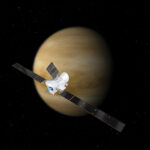- Home
- Transfer
- Transfer examples
- Expedition to Space
Expedition to Space

18.01.2021
One on a Venus flyby, the other on Mars: In 2020, thermal sensors from Leibniz IPHT went on two spectacular space missions
Touchdown confirmed. All over the world, people cheered in front of their screens when the Mars rover Perseverance landed on the Red Planet in February 2021, a good six months after its launch. On board: thermal sensors from Leibniz IPHT. They contribute to one of the goals of the NASA mission – to explore what the weather is like on Mars.
As part of an instrument package developed by the Spanish space agency INSA, the sensors measure, without contact, the temperatures on the surface of the Jezero crater where the rover landed. They are based on the thermoelectric conversion principle and do not require a power supply. This is the third time that the space-tested technology from Leibniz IPHT has been sent to Mars. The institute's sensors have also been installed in the rover Curiosity, which has been operating on the planet since 2012, and in the lander In-Sight, which was launched in November 2018.
Another mission with Jena sensors on board passed Venus in October 2020 – a flyby of the European-Japanese probe BepiColombo on its nearly nine billion kilometer journey to Mercury. The Jena scientists developed the sensor specifically for this mission. It also measures temperature highly accurately and without contact, but in addition, performs significantly more operations at once than the Mars sensor, reports Gabriel Zieger, in whose Thermosensorics working group it was developed. The robust sensor is designed to explore the mineralogical composition of the smallest and so far least explored planet – and to do so under extreme conditions: at temperatures of up to 430 degrees Celsius during the day and minus 180 degrees Celsius at night, braced against the solar wind and high radiation.
"A space mission is a new challenge every time," says Gabriel Zieger. "That's because you only have one shot: you can't test the sensors in the mission area beforehand, and once the mission is launched, they have to work. We have no possibility to readjust anything else." But so far, he adds, it has always worked.


